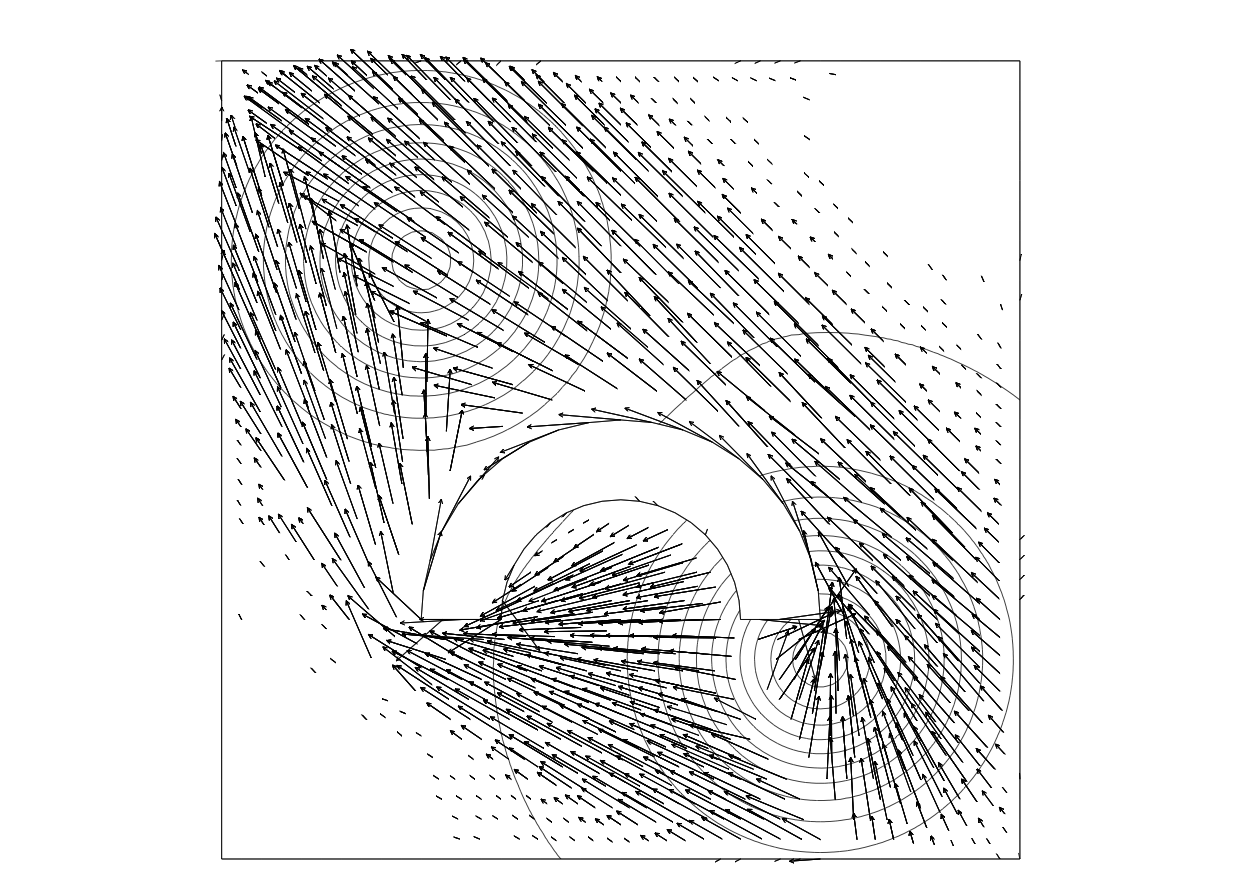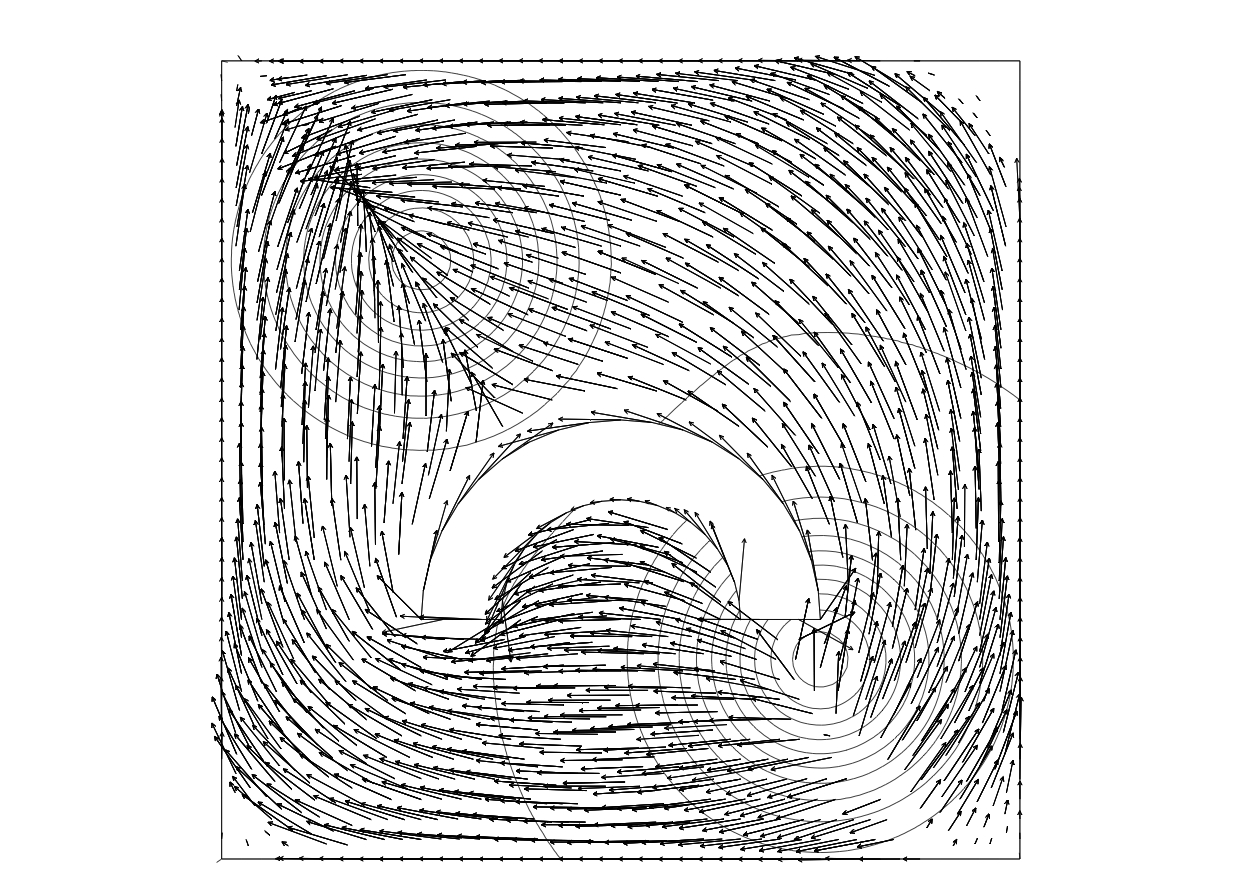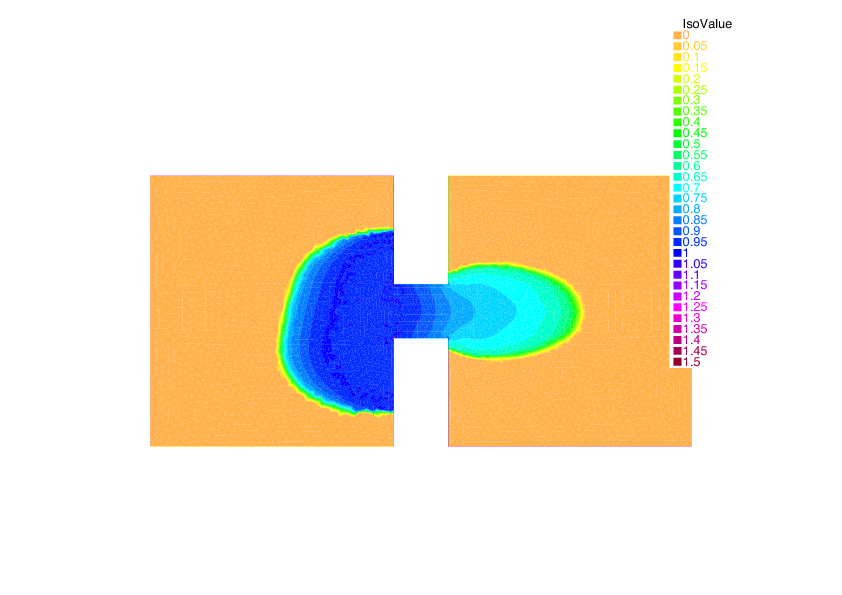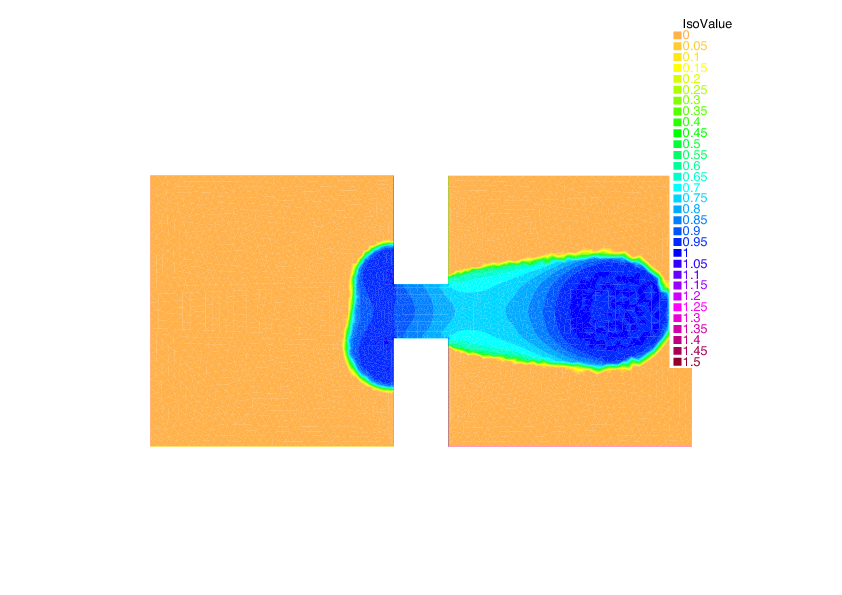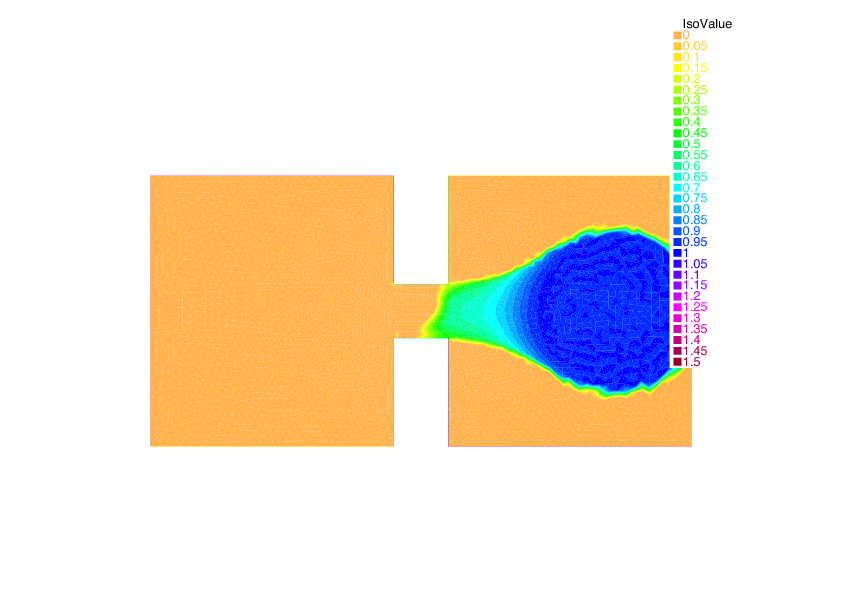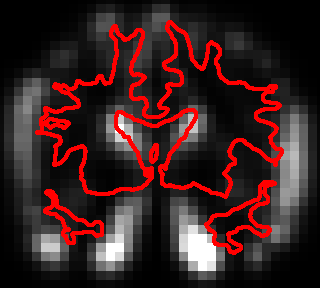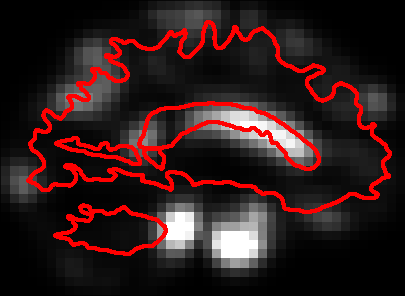Section: Research Program
Modeling and Analysis
The first layer of methodological tools developed by our team is a set of theoretical continuous models that aim at formalizing the problems studied in the applications. These theoretical findings will also pave the way to efficient numerical solvers that are detailed in Section 3.2.
Static Optimal Transport and Generalizations
Convexity constraint and Principal Agent problem in Economics.
(Participants: G. Carlier, J-D. Benamou, V. Duval, Xavier Dupuis (LUISS Guido Carli University, Roma)) The principal agent problem plays a distinguished role in the literature on asymmetric information and contract theory (with important contributions from several Nobel prizes such as Mirrlees, Myerson or Spence) and it has many important applications in optimal taxation, insurance, nonlinear pricing. The typical problem consists in finding a cost minimizing strategy for a monopolist facing a population of agents who have an unobservable characteristic, the principal therefore has to take into account the so-called incentive compatibilty constraint which is very similar to the cyclical monotonicity condition which characterizes optimal transport plans. In a special case, Rochet and Choné [156] reformulated the problem as a variational problem subject to a convexity constraint. For more general models, and using ideas from Optimal Transportation, Carlier [90] considered the more general -convexity constraint and proved a general existence result. Using the formulation of [90] McCann, Figalli and Kim [114] gave conditions under which the principal agent problem can be written as an infinite dimensional convex variational problem. The important results of [114] are intimately connected to the regularity theory for optimal transport and showed that there is some hope to numerically solve the principal-agent problem for general utility functions.
Our expertise: We have already contributed to the numerical resolution of the Principal Agent problem in the case of the convexity constraint, see [95], [146], [143].
Goals: So far, the mathematical PA model can be numerically solved for simple utility functions. A Bregman approach inspired by [54] is currently being developed [93] for more general functions. It would be extremely useful as a complement to the theoretical analysis. A new semi-Discrete Geometric approach is also investigated where the method reduces to non-convex polynomial optimization.
Optimal transport and conditional constraints in statistics and finance.
(Participants: G. Carlier, J-D. Benamou, G. Peyré) A challenging branch of emerging generalizations of Optimal Transportation arising in economics, statistics and finance concerns Optimal Transportation with conditional constraints. The martingale optimal transport [48], [119] which appears naturally in mathematical finance aims at computing robust bounds on option prices as the value of an optimal transport problem where not only the marginals are fixed but the coupling should be the law of a martingale, since it represents the prices of the underlying asset under the risk-neutral probability at the different dates. Note that as soon as more than two dates are involved, we are facing a multimarginal problem.
Our expertise: Our team has a deep expertise on the topic of OT and its generalization, including many already existing collaboration between its members, see for instance [54], [60], [52] for some representative recent collaborative publications.
Goals: This is a non trivial extension of Optimal Transportation theory and Mokaplan will develop numerical methods (in the spirit of entropic regularization) to address it. A popular problem in statistics is the so-called quantile regression problem, recently Carlier, Chernozhukov and Galichon [91] used an Optimal Transportation approach to extend quantile regression to several dimensions. In this approach again, not only fixed marginals constraints are present but also constraints on conditional means. As in the martingale Optimal Transportation problem, one has to deal with an extra conditional constraint. The duality approach usually breaks down under such constraints and characterization of optimal couplings is a challenging task both from a theoretical and numerical viewpoint.
JKO gradient flows.
(Participants: G. Carlier, J-D. Benamou, M. Laborde, Q. Mérigot, V. Duval) The connection between the static and dynamic transportation problems (see Section 2.3) opens the door to many extensions, most notably by leveraging the use of gradient flows in metric spaces. The flow with respect to the transportation distance has been introduced by Jordan-Kindelherer-Otto (JKO) [126] and provides a variational formulation of many linear and non-linear diffusion equations. The prototypical example is the Fokker Planck equation. We will explore this formalism to study new variational problems over probability spaces, and also to derive innovative numerical solvers. The JKO scheme has been very successfully used to study evolution equations that have the structure of a gradient flow in the Wasserstein space. Indeed many important PDEs have this structure: the Fokker-Planck equation (as was first considered by [126]), the porous medium equations, the granular media equation, just to give a few examples. It also finds application in image processing [79]. Figure 4 shows examples of gradient flows.
Our expertise: There is an ongoing collaboration between the team members on the theoretical and numerical analysis of gradient flows.
Goals: We apply and extend our research on JKO numerical methods to treat various extensions:
-
Wasserstein gradient flows with a non displacement convex energy (as in the parabolic-elliptic Keller-Segel chemotaxis model [97])
-
systems of evolution equations which can be written as gradient flows of some energy on a product space (possibly mixing the Wasserstein and structures) : multi-species models or the parabolic-parabolic Keller-Segel model [64]
-
perturbation of gradient flows: multi-species or kinetic models are not gradient flows, but may be viewed as a perturbation of Wasserstein gradient flows, we shall therefore investigate convergence of splitting methods for such equations or systems.
|
From networks to continuum congestion models.
(Participants: G. Carlier, J-D. Benamou, G. Peyré) Congested transport theory in the discrete framework of networks has received a lot of attention since the 50's starting with the seminal work of Wardrop. A few years later, Beckmann proved that equilibria are characterized as solution of a convex minimization problem. However, this minimization problem involves one flow variable per path on the network, its dimension thus quickly becomes too large in practice. An alternative, is to consider continuous in space models of congested optimal transport as was done in [94] which leads to very degenerate PDEs [70].
Our expertise: MOKAPLAN members have contributed a lot to the analysis of congested transport problems and to optimization problems with respect to a metric which can be attacked numerically by fast marching methods [60].
Goals: The case of general networks/anisotropies is still not well understood, general -convergence results will be investigated as well as a detailed analysis of the corresponding PDEs and numerical methods to solve them. Benamou and Carlier already studied numerically some of these PDEs by an augmented Lagrangian method see figure 5. Note that these class of problems share important similarities with metric learning problem in machine learning, detailed below.
|
Diffeomorphisms and Dynamical Transport
Growth Models for Dynamical Optimal Transport.
(Participants: F-X. Vialard, J-D. Benamou, G. Peyré, L. Chizat) A major issue with the standard dynamical formulation of OT is that it does not allow for variation of mass during the evolution, which is required when tackling medical imaging applications such as tumor growth modeling [82] or tracking elastic organ movements [160]. Previous attempts [137], [153] to introduce a source term in the evolution typically lead to mass teleportation (propagation of mass with infinite speed), which is not always satisfactory.
Our expertise: Our team has already established key contributions both to connect OT to fluid dynamics [50] and to define geodesic metrics on the space of shapes and diffeomorphisms [102].
Goals: Lenaic Chizat's PhD thesis aims at bridging the gap between dynamical OT formulation, and LDDDM diffeomorphisms models (see Section 2.3). This will lead to biologically-plausible evolution models that are both more tractable numerically than LDDM competitors, and benefit from strong theoretical guarantees associated to properties of OT.
Mean-field games.
(Participants: G. Carlier, J-D. Benamou) The Optimal Transportation Computational Fluid Dynamics (CFD) formulation is a limit case of variational Mean-Field Games (MFGs), a new branch of game theory recently developed by J-M. Lasry and P-L. Lions [130] with an extremely wide range of potential applications [122]. Non-smooth proximal optimization methods used successfully for the Optimal Transportation can be used in the case of deterministic MFGs with singular data and/or potentials [53]. They provide a robust treatment of the positivity constraint on the density of players.
Our expertise: J.-D. Benamou has pioneered with Brenier the CFD approach to Optimal Transportation. Regarding MFGs, on the numerical side, our team has already worked on the use of augmented Lagrangian methods in MFGs [52] and on the analytical side [89] has explored rigorously the optimality system for a singular CFD problem similar to the MFG system.
Goals: We will work on the extension to stochastic MFGs. It leads to non-trivial numerical difficulties already pointed out in [41].
Macroscopic Crowd motion, congestion and equilibria.
(Participants: G. Carlier, J-D. Benamou, Q. Mérigot, F. Santambrogio (U. Paris-Sud), Y. Achdou (Univ. Paris 7), R. Andreev (Univ. Paris 7)) Many models from PDEs and fluid mechanics have been used to give a description of people or vehicles moving in a congested environment. These models have to be classified according to the dimension (1D model are mostly used for cars on traffic networks, while 2-D models are most suitable for pedestrians), to the congestion effects (“soft” congestion standing for the phenomenon where high densities slow down the movement, “hard” congestion for the sudden effects when contacts occur, or a certain threshold is attained), and to the possible rationality of the agents Maury et al [141] recently developed a theory for 2D hard congestion models without rationality, first in a discrete and then in a continuous framework. This model produces a PDE that is difficult to attack with usual PDE methods, but has been successfully studied via Optimal Transportation techniques again related to the JKO gradient flow paradigm. Another possibility to model crowd motion is to use the mean field game approach of Lions and Lasry which limits of Nash equilibria when the number of players is large. This also gives macroscopic models where congestion may appear but this time a global equilibrium strategy is modelled rather than local optimisation by players like in the JKO approach. Numerical methods are starting to be available, see for instance [41], [78].
Our expertise: We have developed numerical methods to tackle both the JKO approach and the MFG approach. The Augmented Lagrangian (proximal) numerical method can actually be applied to both models [52], JKO and deterministic MFGs.
Goals: We want to extend our numerical approach to more realistic congestion model where the speed of agents depends on the density, see Figure 6 for preliminary results. Comparison with different numerical approaches will also be performed inside the ANR ISOTACE. Extension of the Augmented Lagrangian approach to Stochastic MFG will be studied.
|
Diffeomorphic image matching.
(Participants: F-X. Vialard, G. Peyré, B. Schmitzer, L. Chizat) Diffeomorphic image registration is widely used in medical image analysis. This class of problems can be seen as the computation of a generalized optimal transport, where the optimal path is a geodesic on a group of diffeomorphisms. The major difference between the two approaches being that optimal transport leads to non smooth optimal maps in general, which is however compulsory in diffeomorphic image matching. In contrast, optimal transport enjoys a convex variational formulation whereas in LDDMM the minimization problem is non convex.
Our expertise: F-X. Vialard is an expert of diffeomorphic image matching (LDDMM) [165], [76], [163]. Our team has already studied flows and geodesics over non-Riemannian shape spaces, which allows for piecewise smooth deformations [102].
Goals: Our aim consists in bridging the gap between standard optimal transport and diffeomorphic methods by building new diffeomorphic matching variational formulations that are convex (geometric obstructions might however appear). A related perspective is the development of new registration/transport models in a Lagrangian framework, in the spirit of [159], [160] to obtain more meaningful statistics on longitudinal studies.
Diffeomorphic matching consists in the minimization of a functional that is a sum of a deformation cost and a similarity measure. The choice of the similarity measure is as important as the deformation cost. It is often chosen as a norm on a Hilbert space such as functions, currents or varifolds. From a Bayesian perspective, these similarity measures are related to the noise model on the observed data which is of geometric nature and it is not taken into account when using Hilbert norms. Optimal transport fidelity have been used in the context of signal and image denoising [132], and it is an important question to extends these approach to registration problems. Therefore, we propose to develop similarity measures that are geometric and computationally very efficient using entropic regularization of optimal transport.
Our approach is to use a regularized optimal transport to design new similarity measures on all of those Hilbert spaces. Understanding the precise connections between the evolution of shapes and probability distributions will be investigated to cross-fertilize both fields by developing novel transportation metrics and diffeomorphic shape flows.
The corresponding numerical schemes are however computationally very costly. Leveraging our understanding of the dynamic optimal transport problem and its numerical resolution, we propose to develop new algorithms. These algorithms will use the smoothness of the Riemannian metric to improve both accuracy and speed, using for instance higher order minimization algorithm on (infinite dimensional) manifolds.
Metric learning and parallel transport for statistical applications.
(Participants: F-X. Vialard, G. Peyré, B. Schmitzer, L. Chizat) The LDDMM framework has been advocated to enable statistics on the space of shapes or images that benefit from the estimation of the deformation. The statistical results of it strongly depend on the choice of the Riemannian metric. A possible direction consists in learning the right invariant Riemannian metric as done in [166] where a correlation matrix (Figure 7) is learnt which represents the covariance matrix of the deformation fields for a given population of shapes. In the same direction, a question of emerging interest in medical imaging is the analysis of time sequence of shapes (called longitudinal analysis) for early diagnosis of disease, for instance [115]. A key question is the inter subject comparison of the organ evolution which is usually done by transport of the time evolution in a common coordinate system via parallel transport or other more basic methods. Once again, the statistical results (Figure 8) strongly depend on the choice of the metric or more generally on the connection that defines parallel transport.
Our expertise: Our team has already studied statistics on longitudinal evolutions in [115], [116].
Goals: Developing higher order numerical schemes for parallel transport (only low order schemes are available at the moment) and developing variational models to learn the metric or the connections for improving statistical results.
|
|
Sparsity in Imaging
Inverse problems over measures spaces.
(Participants: G. Peyré, V. Duval, C. Poon, Q. Denoyelle) As detailed in Section 2.4, popular methods for regularizing inverse problems in imaging make use of variational analysis over infinite-dimensional (typically non-reflexive) Banach spaces, such as Radon measures or bounded variation functions.
Our expertise: We have recently shown in [164] how – in the finite dimensional case – the non-smoothness of the functionals at stake is crucial to enforce the emergence of geometrical structures (edges in images or fractures in physical materials [65]) for discrete (finite dimensional) problems. We extended this result in a simple infinite dimensional setting, namely sparse regularization of Radon measures for deconvolution [110]. A deep understanding of those continuous inverse problems is crucial to analyze the behavior of their discrete counterparts, and in [111] we have taken advantage of this understanding to develop a fine analysis of the artifacts induced by discrete (i.e. which involve grids) deconvolution models. These works are also closely related to the problem of limit analysis and yield design in mechanical plasticity, see [92], [65] for an existing collaboration between Mokaplan 's team members.
Goals: A current major front of research in the mathematical analysis of inverse problems is to extend these results for more complicated infinite dimensional signal and image models, such as for instance the set of piecewise regular functions. The key bottleneck is that, contrary to sparse measures (which are finite sums of Dirac masses), here the objects to recover (smooth edge curves) are not parameterized by a finite number of degrees of freedom. The relevant previous work in this direction are the fundamental results of Chambolle, Caselles and co-workers [49], [43], [98]. They however only deal with the specific case where there is no degradation operator and no noise in the observations. We believe that adapting these approaches using our construction of vanishing derivative pre-certificate [110] could lead to a solution to these theoretical questions.
Sub-Riemannian diffusions.
(Participants: G. Peyré, J-M. Mirebeau, D. Prandi) Modeling and processing natural images require to take into account their geometry through anisotropic diffusion operators, in order to denoise and enhance directional features such as edges and textures [152], [112]. This requirement is also at the heart of recently proposed models of cortical processing [151]. A mathematical model for these processing is diffusion on sub-Riemanian manifold. These methods assume a fixed, usually linear, mapping from the 2-D image to a lifted function defined on the product of space and orientation (which in turn is equipped with a sub-Riemannian manifold structure).
Our expertise: J-M. Mirebeau is an expert in the discretization of highly anisotropic diffusions through the use of locally adaptive computational stencils [144], [112]. G. Peyré has done several contributions on the definition of geometric wavelets transform and directional texture models, see for instance [152]. Dario Prandi has recently applied methods from sub-Riemannian geometry to image restoration [67].
Goals: A first aspect of this work is to study non-linear, data-adaptive, lifting from the image to the space/orientation domain. This mapping will be implicitly defined as the solution of a convex variational problem. This will open both theoretical questions (existence of a solution and its geometrical properties, when the image to recover is piecewise regular) and numerical ones (how to provide a faithful discretization and fast second order Newton-like solvers). A second aspect of this task is to study the implication of these models for biological vision, in a collaboration with the UNIC Laboratory (directed by Yves Fregnac), located in Gif-sur-Yvette. In particular, the study of the geometry of singular vectors (or “ground states” using the terminology of [61]) of the non-linear sub-Riemannian diffusion operators is highly relevant from a biological modeling point of view.
Sparse reconstruction from scanner data.
(Participants: G. Peyré, V. Duval, C. Poon) Scanner data acquisition is mathematically modeled as a (sub-sampled) Radon transform [123]. It is a difficult inverse problem because the Radon transform is ill-posed and the set of observations is often aggressively sub-sampled and noisy [158]. Typical approaches [129] try to recover piecewise smooth solutions in order to recover precisely the position of the organ being imaged. There is however a very poor understanding of the actual performance of these methods, and little is known on how to enhance the recovery.
Our expertise: We have obtained a good understanding of the performance of inverse problem regularization on compact domains for pointwise sources localization [110].
Goals: We aim at extending the theoretical performance analysis obtained for sparse measures [110] to the set of piecewise regular 2-D and 3-D functions. Some interesting previous work of C. Poon et al [154] (C. Poon is currently a postdoc in Mokaplan ) have tackled related questions in the field of variable Fourier sampling for compressed sensing application (which is a toy model for fMRI imaging). These approaches are however not directly applicable to Radon sampling, and require some non-trivial adaptations. We also aim at better exploring the connection of these methods with optimal-transport based fidelity terms such as those introduced in [40].
Tumor growth modeling in medical image analysis.
(Participants: G. Peyré, F-X. Vialard, J-D. Benamou, L. Chizat) Some applications in medical image analysis require to track shapes whose evolution is governed by a growth process. A typical example is tumor growth, where the evolution depends on some typically unknown but meaningful parameters that need to be estimated. There exist well-established mathematical models [82], [150] of non-linear diffusions that take into account recently biologically observed property of tumors. Some related optimal transport models with mass variations have also recently been proposed [139], which are connected to so-called metamorphoses models in the LDDMM framework [62].
Our expertise: Our team has a strong experience on both dynamical optimal transport models and diffeomorphic matching methods (see Section 3.1.2).
Goals: The close connection between tumor growth models [82], [150] and gradient flows for (possibly non-Euclidean) Wasserstein metrics (see Section 3.1.2) makes the application of the numerical methods we develop particularly appealing to tackle large scale forward tumor evolution simulation. A significant departure from the classical OT-based convex models is however required. The final problem we wish to solve is the backward (inverse) problem of estimating tumor parameters from noisy and partial observations. This also requires to set-up a meaningful and robust data fidelity term, which can be for instance a generalized optimal transport metric.




